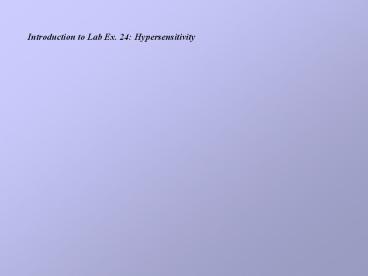Introduction to Lab Ex. 24: Hypersensitivity PowerPoint PPT Presentation
Title: Introduction to Lab Ex. 24: Hypersensitivity
1
Introduction to Lab Ex. 24 Hypersensitivity
2
Introduction to Lab Ex. 24 Hypersensitivity
- Response to antigens (allergens) leading to
damage - Require sensitizing dose(s)
Hypersensitivity is thus an exaggerated response
of the immune system. There are 4 types of
hypersensitivity reactions - Type 1 IgE
mediated Anaphylaxis reactions - Type 2
Cytotoxic reactions (IgG/IgM) - Type 3 Immune
complex reactions (IgG) - Type 4 TD cell
mediated reactions Types 1, 2, 3 are antibody
mediated and are of the Immediate type Type 4 is
cell (TD)mediated and is of the Delayed type
3
Type I (Anaphylactic) Reactions
- Involve IgE antibodies, mast cells, basophils
- Localized Hives or asthma from contact or
inhaled antigens - Systemic Shock from ingested or injected antigens
Figure 19.1a
4
On first exposure (sensitizing) to allergen IgE
antibodies are formed. IgE antibodies
circulate through the body and bind by their Fc
portions to receptors on the surface of mast
cells and basophils. On reexposure to the same
antigen, binding of the antigen to IgE on the
surface of mast cells and basophils could lead
to crossbridging Crossbridging stimulates the
degranulation of the mast cells.
5
Mast cells - found in connective tissue of the
skin, respiratory tract and in surrounding
blood vessels - contain granules with chemicals
(mediators) - have many receptors for Fc portion
of IgE - cross bridging causes
degranulation Basophils - circulate in blood
stream - contain granules with chemicals
(mediators) Mediators include - histamine -
leukotrienes - prostaglandins
6
(No Transcript)
7
Histamine effects - increase permeability of
capillaries - cause swelling and redness -
increase mucous secretion - cause smooth muscle
contraction Leukotrienes effects - cause
prolonged smooth muscle contraction (spasms of
the bronchial tubes) Prostaglandin effects -
cause mucous secretion - cause smooth muscle
contraction (respiratory system) Results of
allergic reaction inflammation (neutrophils,
eosinophils) - distension of capillaries,
swelling, mucus secretion, smooth muscle
contractions
8
Type I (Anaphylactic) Reactions
- Skin testing
- RAST to identify allergens
Figure 19.3
9
Treatment/ therapy - Antihistamine block
histamine binding sites in nose and skin -
Desensitization stimulate IgG production to
allergen (allergy shots) - Cromolyn sodium
stabilizes mast cell membranes, thus inhibiting
histamine release in nasal tissues/bronchial muc
us membranes - Epinephrine relaxes smooth
muscles in lung constricts blood vessels
(raises blood pressure) immediate action

